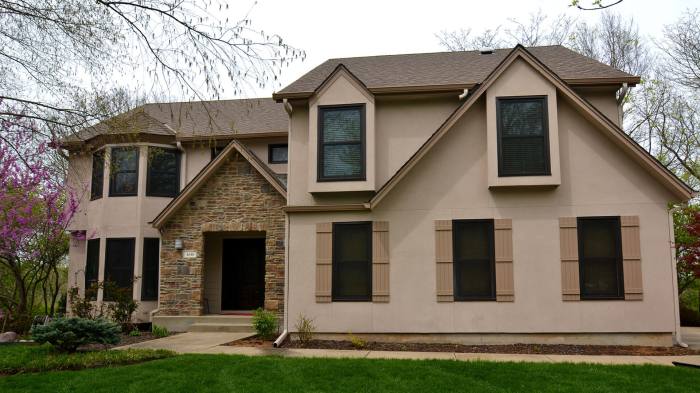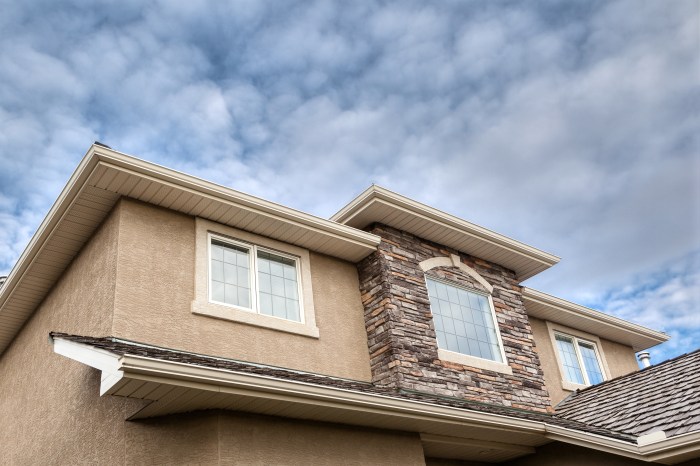Exploring the World of Stucco House Siding
Embark on a journey through the intricate world of stucco house siding, where tradition meets modernity in a seamless blend of functionality and style. Discover the rich history, diverse finishes, and practical installation methods that make stucco a timeless choice for homeowners.
As we delve deeper into the nuances of stucco house siding, you'll uncover the key elements that set this unique material apart from the rest, offering a glimpse into a world of architectural possibilities.
Overview of Stucco House Siding
Stucco house siding is a type of exterior finish that is applied to the walls of a house to protect it from the elements and provide a decorative finish. It is made of cement, sand, lime, and water, and can be tinted to various colors to suit the homeowner's preferences.Stucco siding is known for its durability and low maintenance requirements.
It is resistant to fire, rot, and pests, making it a popular choice for homeowners looking for a long-lasting siding option. Additionally, stucco can be easily repaired if damaged, ensuring the longevity of the siding.
History and Evolution of Stucco as a Popular Siding Option
Stucco has been used as a building material for centuries, with origins dating back to ancient Greece and Rome. It was traditionally made with lime and sand, giving it a smooth, plaster-like finish. Over time, stucco has evolved to include cement as a primary ingredient, increasing its strength and durability.In the 20th century, stucco became a popular siding option in the United States, particularly in the southwestern states where the dry climate is conducive to its application.
Today, stucco is a common choice for homeowners across the country, valued for its versatility and aesthetic appeal.
Comparison with Other Common Siding Materials
When compared to other common siding materials such as vinyl, wood, and brick, stucco offers unique benefits. In terms of durability, stucco is highly resistant to damage from weather and pests, outlasting many other materials. While stucco requires occasional maintenance such as repainting, it is generally easier to maintain than wood siding, which may require regular staining or sealing.Overall, stucco house siding provides a durable and attractive option for homeowners seeking a long-lasting exterior finish for their homes.
Types of Stucco Finishes
When it comes to stucco house siding, there are various types of finishes available to choose from, each offering a unique look and feel to the exterior of your home.
Smooth Stucco Finish
A smooth stucco finish provides a sleek and modern appearance to the house. This type of finish is achieved by troweling the stucco mixture evenly across the surface, creating a seamless and polished look. Smooth stucco finishes are easy to clean and maintain, making them a popular choice for many homeowners looking for a clean aesthetic.
Textured Stucco Finish
Textured stucco finishes add depth and dimension to the exterior of the house. This finish is created by using various techniques, such as stippling or creating patterns with a trowel, to give the stucco surface a more tactile and visually interesting appearance.
Textured finishes can help conceal imperfections in the wall and add a unique character to the home.
Rough Stucco Finish
Rough stucco finishes offer a more rustic and natural look to the house. This finish is achieved by leaving the stucco mixture slightly uneven or by using a texture roller to create a rough surface. Rough stucco finishes are great for adding a sense of authenticity and charm to the exterior of a home, giving it a timeless and weathered appearance.Each type of stucco finish has its own aesthetic appeal and practical considerations, so it's important to choose the one that best suits your personal style and the overall look you want to achieve for your home.
Installation Process of Stucco Siding

When it comes to installing stucco siding on a house, it is essential to follow a systematic process to ensure a successful outcome. From surface preparation to applying the stucco finish, each step plays a crucial role in the durability and aesthetics of the final result.
Preparation of the Surface
Before applying stucco siding, the surface of the house must be properly prepared to ensure adhesion and longevity. Here are the key steps involved in surface preparation:
- Clean the surface thoroughly to remove any dirt, dust, or debris that could interfere with the stucco application.
- Repair any cracks or damage in the existing surface to create a smooth and even base for the stucco.
- Apply a bonding agent or primer to improve the adhesion of the stucco to the surface.
- Install a moisture barrier to protect the underlying structure from water damage.
Tools and Materials Needed
To successfully install stucco siding, you will need the following tools and materials:
- Trowels for applying and shaping the stucco.
- Stucco mix for creating the stucco finish.
- Wire mesh or lath to provide support for the stucco on the surface.
- Buckets for mixing the stucco and carrying it to the application area.
- Scaffolding or ladders for reaching higher areas of the house.
- Protective gear such as gloves, goggles, and masks to ensure safety during the installation process.
Pros and Cons of Stucco House Siding

Stucco house siding offers a range of benefits but also comes with its own set of challenges. Understanding the pros and cons can help homeowners make an informed decision when considering this material for their home exterior.
Advantages of Stucco House Siding
- Durability: Stucco is a highly durable material that can withstand harsh weather conditions and last for many years.
- Energy Efficiency: Stucco provides excellent insulation, helping to regulate indoor temperatures and reduce energy costs.
- Aesthetic Appeal: Stucco offers a timeless and elegant look that can enhance the curb appeal of any home.
- Low Maintenance: Stucco requires minimal maintenance compared to other siding materials, saving time and effort for homeowners.
Challenges of Stucco House Siding
- Moisture Issues: Stucco is prone to moisture infiltration, which can lead to mold, mildew, and structural damage if not properly maintained.
- Cracking: Stucco can develop cracks over time, especially in areas with extreme temperature changes, requiring timely repairs to prevent further damage.
- Cost: The initial installation cost of stucco siding can be higher than other materials, which may deter some homeowners on a tight budget.
- Color Fading: Stucco colors may fade over time due to exposure to sunlight, requiring repainting or refinishing to maintain the aesthetic appeal.
Tips for Maintaining Stucco Siding
- Regular Inspections: Conduct routine inspections to identify any cracks, chips, or signs of moisture damage early on.
- Sealing and Caulking: Seal any gaps or cracks in the stucco to prevent moisture infiltration and prolong the lifespan of the siding.
- Cleaning: Periodically clean the stucco surface using a mild detergent and water to remove dirt, debris, and mold buildup.
- Repairs: Promptly repair any damaged areas of stucco to prevent further deterioration and maintain the integrity of the siding.
Stucco House Siding Maintenance
Maintaining your stucco house siding is essential to ensure its longevity and appearance. Proper maintenance practices can help prevent common issues like cracking and discoloration, keeping your home looking beautiful for years to come.
Cleaning Stucco Siding
Regularly cleaning your stucco siding can help prevent dirt, grime, and mold buildup. Use a mixture of mild detergent and water to gently scrub the surface with a soft-bristled brush. Avoid using pressure washers, as they can damage the stucco finish.
Repairing Stucco Siding
If you notice any cracks or damage to your stucco siding, it's important to address them promptly. Start by cleaning the area and removing any loose debris. Then, apply a stucco patching compound to fill in the cracks. Smooth out the surface and allow it to dry completely before repainting.
Repainting Stucco Siding
Repainting your stucco siding can help refresh its appearance and protect it from the elements. Choose a high-quality acrylic paint specifically designed for stucco surfaces. Before painting, make sure to clean the surface thoroughly and repair any damage. Apply the paint evenly with a roller or brush for a smooth finish.
Preventing Issues with Stucco Siding
To prevent common issues like cracking or discoloration in stucco siding, it's important to maintain proper drainage around your home. Ensure that gutters are clear of debris and that water is directed away from the foundation. Inspect your stucco siding regularly for any signs of damage and address them promptly to prevent larger issues.
Concluding Remarks
In conclusion, stucco house siding stands as a testament to both durability and aesthetic appeal, providing homeowners with a versatile and reliable option for their exterior needs. From maintenance tips to creative finishes, the world of stucco awaits your exploration.
Answers to Common Questions
How long does stucco house siding typically last?
With proper maintenance, stucco house siding can last anywhere from 50 to 80 years, making it a long-lasting investment for your home.
Can stucco siding be painted to change its color?
Yes, stucco siding can be painted to give your home a fresh look. Make sure to use breathable paint specifically designed for stucco surfaces.
Is stucco siding prone to cracking over time?
While stucco is a durable material, it can develop hairline cracks due to settling or weather conditions. Regular inspections and repairs can help prevent larger issues.




